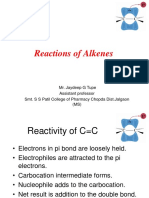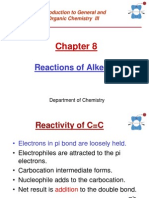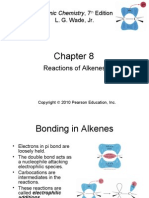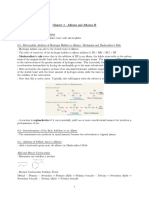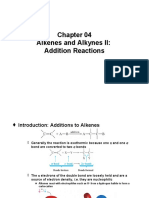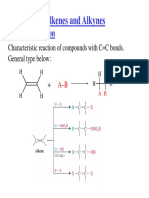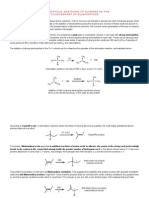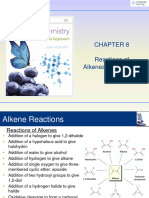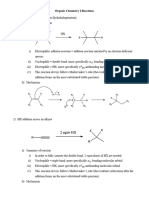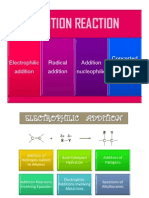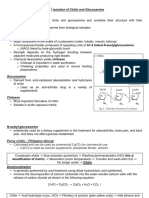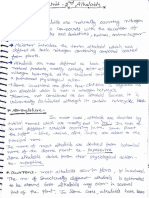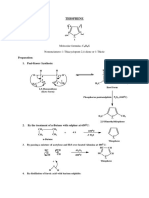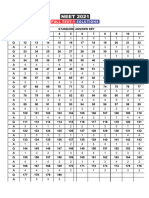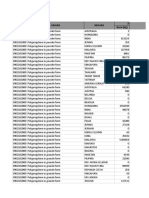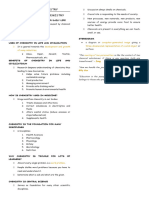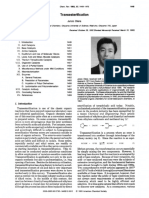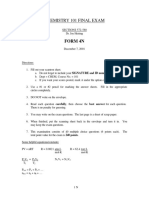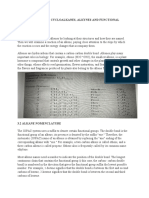Chapter 8
Alkenes and Alkynes II: Addition Reactions
Created by Professor William Tam & Dr. Phillis Chang
Ch. 8 - 1
�About The Authors
These PowerPoint Lecture Slides were created and prepared by Professor William Tam and his wife, Dr. Phillis Chang. Professor William Tam received his B.Sc. at the University of Hong Kong in 1990 and his Ph.D. at the University of Toronto (Canada) in 1995. He was an NSERC postdoctoral fellow at the Imperial College (UK) and at Harvard University (USA). He joined the Department of Chemistry at the University of Guelph (Ontario, Canada) in 1998 and is currently a Full Professor and Associate Chair in the department. Professor Tam has received several awards in research and teaching, and according to Essential Science Indicators, he is currently ranked as the Top 1% most cited Chemists worldwide. He has published four books and over 80 scientific papers in top international journals such as J. Am. Chem. Soc., Angew. Chem., Org. Lett., and J. Org. Chem. Dr. Phillis Chang received her B.Sc. at New York University (USA) in 1994, her M.Sc. and Ph.D. in 1997 and 2001 at the University of Guelph (Canada). She lives in Guelph with her husband, William, and their son, Matthew.
Ch. 8 - 2
�1. Addition Reactions of Alkenes
E C C + E Nu C C Nu
Ch. 8 - 3
�1A. How To Understand Additions to Alkenes
This is an addition reaction: ENu added across the double bond E
+ E
Nu
C
2 s-bonds Bonds formed
C Nu
p-bond
s-bond
Bonds broken
Ch. 8 - 4
Since p bonds are formed from the overlapping of p orbitals, p electron clouds are above and below the plane of the double bond
p electron clouds
Ch. 8 - 5
Electrophilic electron seeking C=C and CC p bonds are particularly susceptible to electrophilic reagents (electrophiles)
Common electrophile H+, X+ (X = Cl, Br, I), Hg2+, etc.
Ch. 8 - 6
In an electrophilic addition, the p electrons seek an electrophile, breaking the p bond, forming a s bond and leaving a positive charge on the vacant p orbital on the adjacent carbon. Addition of B to form a s bond provides an addition product
Ch. 8 - 7
Nu
E C C + Nu
Nu E C C
Ch. 8 - 8
�2. Electrophilic Addition of Hydrogen Halides to Alkenes: Mechanism and Markovnikovs Rule
Mechanism
E Nu
A C C
Nu
Nu E C C
Ch. 8 - 9
Mechanism Sometimes do not go through a free carbocation, may go via
E C C
Ch. 8 - 10
Markovnikovs Rule For symmetrical substrates, no problem for regiochemistry
H C H E Nu E H C H C H Nu E H C H Nu C H same H as H Nu E C H C H H same H as H E C H C H H
H C H
Ch. 8 - 11
Markovnikovs Rule But for unsymmetrical substrates, two regioisomers are possible
H C H C H E Nu E CH3 C H C H Nu E CH3 C H Nu C H different H from CH3 H or CH3 C H E C H Nu Nu E C H C H
Ch. 8 - 12
H3C
Markovnikovs Rule In the electrophilic addition of an unsymmetrical electrophile across a double bond of an alkene, the more highly substituted and more stabilized carbocation is formed as the intermediate in preference to the less highly substituted and less stable one
Ch. 8 - 13
Markovnikovs Rule Thus
E Nu E Nu E
E NOT
o o o
Note: carbocation stability 3 > 2 > 1
Ch. 8 - 14
Addition of Hydrogen Halides Addition of HCl, HBr and HI across a C=C bond + H is the electrophile
+ H
Br
slow r.d.s
Br fast
Br
Br NO
Ch. 8 - 15
�Ch. 8 - 16
�2A. Theoretical Explanation of Markovnikovs Rule
H3C C H C H H H X
step 1 (slow r.d.s.) H CH3 C C H or CH3 H H 2o carbocation (more stable) H C C H H H 1o carbocation (more stable)
One way to state Markovnikovs rule is to say that in the addition of HX to an alkene, the hydrogen atom adds to the carbon atom of the double bond that already has the greater number of hydrogen atoms
Ch. 8 - 17
�
H Br slow (r.d.s.)
Br
H Br
(1o cation) fast
(minor)
Br Br (major)
(2o cation) fast
Step 1
Step 2
Ch. 8 - 18
�Ch. 8 - 19
�
(1)
Examples
H Cl Cl + H (95 :
H + Br (98 H : 2)
Ch. 8 - 20
H Cl 5)
Br
(2)
Br
�2B. Modern Statement of Markovnikovs Rule
In the ionic addition of an unsymmetrical reagent to a double bond, the positive portion of the added reagent attaches itself to a carbon atom of the double bond so as to yield the more stable carbocation as an intermediate
Ch. 8 - 21
Examples
OH Cl
OH Cl (major)
(1)
Cl OH
more stable 3o cation
Cl
OH
Cl OH
less stable 1o cation
(minor)
Ch. 8 - 22
Examples
Cl I
I
I Cl (major)
(2)
Cl
more stable 3o cation
Cl I less stable 1o cation I (minor)
Cl
Ch. 8 - 23
�2C. Regioselective Reactions
When a reaction that can potentially yield two or more constitutional isomers actually produces only one (or a predominance of one), the reaction is said to be regioselective
H Cl Cl + (major) H Cl (minor) H
regioisomers Regioselectivity: 95 : 5
Ch. 8 - 24
�2D. An Exception to Markovnikovs Rule
H Br H Br (anti-Markovnikov's product)
RO OR heat
Via a radical mechanism (see Chapter 10)
This anti-Markovnikov addition does not take place with HI, HCl, and HF, even when peroxides are present
Ch. 8 - 25
�3. Stereochemistry of the Ionic Addition to an Alkene
attack from top
H C Bu C H H
X
X H C CH3
H Bu
CH2
achiral trigonal planar carbocation
X
Bu
H C CH3
attack from bottom
X (R)-2-Halohexane (50%)
Ch. 8 - 26
racemate
Bu (S)-2-Halohexane (50%)
�4. Addition of Sulfuric Acid to Alkenes
conc. H2SO4 cold
O HO S O O H
OSO3H H
OSO3H
H
more stable o 3 cation
Addition of HOSO3H across a C=C bond
less stable o 1 cation
Ch. 8 - 27
�4A. Alcohols from Alkyl Hydrogen Sulfates
conc. H2SO4 cold OSO3H H H2O heat OH H
The overall result of the addition of sulfuric acid to an alkene followed by hydrolysis is the Markovnikov addition of H and OH
Ch. 8 - 28
�5. Addition of Water to Alkenes: Acid-Catalyzed Hydration
Overall process Addition of HOH across a C=C bond + H is the electrophile Follow Markovnikovs rule
H2O dilute H3O+ (e.g. dilute H2SO4, H3PO4) OH H
Ch. 8 - 29
�5A. Mechanism
H H O H
H 2O
H
slow (step 1)
fast (step 2) O
more stable 3o cation
H
fast (step 3) H
H
H 2O
H H + OH
Ch. 8 - 30
�5B. Rearrangements
Rearrangement can occur with certain carbocations
H2O H2SO4 H
1,2-alkyl shift
NOT OH
OH
H 2O
(major product)
Ch. 8 - 31
�6.
Alcohols from Alkenes through OxymercurationDemercuration: Markovnikov Addition Step 1: Oxymercuration
C C Hg(OAc) 2 THF-H2O C HO C HgOAc
Step 2: Demercuration
C HO C HgOAc NaBH4 OH C HO C H
Ch. 8 - 32
�6A. Regioselectivity of OxymercurationDemercuration
Oxymercurationdemercuration is also highly regioselective and follows Markovnikovs rule
Hg(OAc) 2 THF-H2O HO HgOAc NaBH4 OH
H HO
Ch. 8 - 33
�6B. Rearrangements Seldom Occur in OxymercurationDemercuration
Recall: acid-catalyzed hydration of some alkenes leads to rearrangement products
e.g. H2O H2SO4 OH H
Ch. 8 - 34
�H2O H2SO4
1,2-alkyl shift
H H
H 2O
H 2O
OH H
Ch. 8 - 35
Rearrangements of the carbon skeleton seldom occur in oxymercuration demercuration
OH 1. Hg(OAc)2, THF-H2O 2. NaBH4 H
no rearrangement
via
OH
Hg(OAc)
Ch. 8 - 36
�6C. Mechanism of Oxymercuration
Does not undergo a free carbocation
Hg OAc OAc
HgOAc AcO +
HgOAc
H 2O
HgOAc
HO
H 2O
H
H
Ch. 8 - 37
Stereochemistry Usually anti-addition
Hg(OAc) 2 H3C
H 2O
H3C
THF-H2O
Hg(OAc)
OH
CH3
Hg(OAc)
Ch. 8 - 38
�Although attack by water on the bridged mercurinium ion leads to anti addition of the hydroxyl and mercury groups, the reaction that replaces mercury with hydrogen is not stereocontrolled (it likely involves radicals). This step scrambles the overall stereochemistry The net result of oxymercuration demercuration is a mixture of syn and anti addition of H and OH to the alkene Ch. 8 - 39
Solvomercuration-Demercuration
Hg(O2CCF3)2 THF-ROH OR Hg(O2CCF3) NaBH4 OH OR H
Ch. 8 - 40
�7.
Alcohols from Alkenes through HydroborationOxidation: Anti-Markovnikov Syn Hydration
"BH3"
C H
C BH2
Addition of HBH2 across a C=C bond
Ch. 8 - 41
BH3 exists as dimer B2H6 or complex with coordinative solvent
H H B H H H B H (BH3-THF) O H H B H H B H (BH3-DMS)
Ch. 8 - 42
Me S Me
�syn addition
1. BH3-THF H3C H 2. H2O2, OH H OH
CH3
Anti-Markovnikov addition of H & OH
Ch. 8 - 43
Compare with oxymercurationdemercuration
Hg(OAc) 2 OH H
H3C
THF-H2O
CH3
Hg(OAc) NaBH4
anti addition
OH
Markovnikov addition of H & OH
CH3
Ch. 8 - 44
�8. Hydroboration: Synthesis of Alkylboranes
hydroboration
+H
C H
C B
alkene
boron hydride
alkylborane
Ch. 8 - 45
�8A. Mechanism of Hydroboration
H3C H H + B H H H H
H
H3C H H B H H H
H3C H H B H H H H
H p complex
H3C H
H H
four-atom concerted T.S.
H3C H H B
H H
H B syn addition H of H and B
H
Ch. 8 - 46
�
(1)
Other examples
H BH2-THF H BH2 (99 : 1) + H2B H
(2)
BH2-THF H BH2 (98
+ H2B : 2)
Ch. 8 - 47
�8B. Stereochemistry of Hydroboration
Syn addition
H BH3-THF BH2
H3C
CH3
Ch. 8 - 48
�9. Oxidation and Hydrolysis of Alkylboranes
H H B B H H BH2
B always ends up on the least hindered carbon
B H (trialkyl borane)
B H
Ch. 8 - 49
Oxidation
H2O2 O
O B O
Ch. 8 - 50
� Via
R
R
R3B
OH
B R
OH
OR
HO
R RO B OR
OR
R R B O OR OH
OH
R O HO B OR OR
RO
OR
Ch. 8 - 51
Hydrolysis
O O B O NaOH H2O
OH
+ Na3BO3
Ch. 8 - 52
Overall synthetic process of hydroboration-oxidation-hydrolysis
1. BH3-THF 2. H2O2 3. NaOH, H2O H OH
Overall: anti-Markovnikov addition of HOH across a C=C bond Opposite regioisomers as oxymercuration-demercuration
Ch. 8 - 53
Example
BH3-THF H3C H
H OH
anti-Markovnikov syn addition
H BH2
CH3
H
H2O2 OH
CH3
This oxidation step occurs with
retention of configuration
Ch. 8 - 54
�10. Summary of Alkene Hydration Methods
Summary of Methods for Converting Alkene to Alcohol
Reaction
Acid-catalyzed hydration Oxymercurationdemercuration Hydroborationoxidation
Regiochemistry
Markovnikov addition Markovnikov addition
Stereochemistry
Not controlled
Occurrence of Rearrangements
Frequent
Not controlled
Seldom
Anti-Markovnikov Stereospecific: addition syn addition of H and OH
Seldom
Ch. 8 - 55
Examples
H H2O
via H
1,2-hydride shift
OH
with rearrangement
OH
1. Hg(OAc)2, THF-H2O 2. NaBH4, OH
Markovnikov addition of H2O without rearrangement
H 1. BH3-THF 2. H2O2, OH
anti-MarkovniOH kov, syn addition of H2O
Ch. 8 - 56
�11. Protonolysis of Alkylboranes
R B CH3CO2H heat R H + CH3CO2 B
alkylborane
alkane
Protonolysis of an alkylborane takes place with retention of configuration; hydrogen replaces boron where it stands in the alkylborane Overall stereochemistry of hydroboration protonolysis: syn Ch. 8 - 57
e.g.
1. BH3-THF H3C 2. CH3CO2D H H3C H
H D + enantiomer
via H3C H BH2 H
Ch. 8 - 58
�12. Electrophilic Addition of Bromine and Chlorine to Alkenes
Addition of XX (X = Cl, Br) across a C=C bond
C C Br2 CCl4 Br C C Br (vicinal dibromide)
Ch. 8 - 59
�
(1)
Examples
Br2 5 C (anti addition of Br2)
o
Br + Br (racemate)
Br Br
Cl (2) Ph Cl2 Ph 10oC Ph
1 2
Ph
(anti addition of Cl2)
Cl
Ph same as Cl
Ph Cl
Ch. 8 - 60
(rotation of C1-C2 bond)
�12A. Mechanism of Halogen Addition
C C + Br Br
BrBr bond becomes polarized when close to alkene
Br Br
Br
+ Br
Br
(vincinal Dibromide)
Br
(bromonium)
Ch. 8 - 61
Stereochemistry Anti addition
Br Br
CCl4
Br Br
H enantiomer + Br (anti)
Br
SN2 reaction
H
Ch. 8 - 62
�13. Stereospecific Reactions
A reaction is stereospecific when a particular stereoisomeric form of the starting material reacts by a mechanism that gives a specific stereoisomeric form of the product
Ch. 8 - 63
� Reaction 1
H H3C CH3 H Br2 CCl4 Br H C H3C CH3 C H Br Br H H3C Br H CH3
trans-2-Butene
(2R,3S)-2,3-Dibromobutane
(a meso compound)
Reaction 2
H H3C H CH3 Br2 CCl4 Br H H3C C H C CH3 + H3C Br Br H C C Br H CH3
cis-2-Butene
(2R,3R)
(2S,3S)
Ch. 8 - 64
(a pair of enantiomers)
Addition of bromine to cis-2-Butene
(a) Br C H C CH3 H Br H3C (2R,3R)-2,3-Dibromobutane (chiral)
(a)
H H3C H CH3 Br
Br
(b)
H C
H3C
H C Br
CH3
Br
bromonium ion (achiral)
H (b) H3C C C
Br
H Br CH3 (2S,3S)-2,3-Dibromobutane (chiral)
Ch. 8 - 65
Addition of bromine to trans-2-Butene
(a) Br H C Br H3C (R,S)-2,3-Dibromobutane (meso) CH3 C H
(a)
H H3C CH3 H Br
Br
C Br
(b)
CH3 C H
H3C
Br
bromonium ion (b) (achiral)
H H3C C C
Br CH3
Br H (R,S)-2,3-Dibromobutane (meso)
Ch. 8 - 66
�14. Halohydrin Formation
X2 H2O OH C C X
Addition of OH and X (X = Cl, Br) across a C=C bond + X is the electrophile Follow Markovnikovs rule
Ch. 8 - 67
Mechanism
Br Br
H3C
Br
H2O
H3C
H2O
OH
H3C
Br
CH3
Br
Ch. 8 - 68
Other variation If H2O is replaced by ROH, RH will be the nucleophile
e.g. Br2 MeOH OMe Br
Ch. 8 - 69
�15. Divalent Carbon Compounds: Carbenes
15A. Structure and Reactions of Methylene
heat or light
CH2
CH2
Diazomethane
Methylene Nitrogen (a carbene)
Ch. 8 - 70
�CH2 I
H2C
N II
CH2
N III
CH2
C C
Alkene
Methylene
H H Cyclopropane
Ch. 8 - 71
�15B. Reactions of Other Carbenes: Dihalocarbenes :CX2 (e.g. :CCl2) Generation by a-elimination of chloroform
H Cl Cl C Cl
OtBu
+ tBuOH + Cl CCl2
Ch. 8 - 72
Usually a syn (cis) addition across a C=C bond
t
BuOK
H Cl H Cl
CHCl3
(a cyclopropane)
Ch. 8 - 73
Stereospecific reactions
CCl2 Cl Cl
CCl2
Cl
Cl
Ch. 8 - 74
�15C. Carbenoids: The Simmons-Smith Cyclopropane Synthesis
CH2I2
Zn(Cu)
(Zinc-copper couple)
C H2 (a carbenoid)
ZnI
Ch. 8 - 75
A stereospecific syn (cis) addition across a C=C bond
CH2I2 Zn(Cu) (trans) (trans)
CH2I2 Zn(Cu) (cis) (cis)
Ch. 8 - 76
�16. Oxidation of Alkenes: Syn 1,2-Dihydroxylation
Overall: addition of 2 OH groups across a C=C bond
C C OH OH
Reagents: dilute KMnO4 / OH / H2O / cold or OsO4, pyridine then NaHSO3, H2O
Ch. 8 - 77
�16A. Mechanism for Syn Dihydroxylation of Alkenes
dil. KMnO4 OH, H2O cold O C C C OsO4 pyridine O O C O Os O C O Mn C O O OH H2O C C
OH OH + MnO 2
NaHSO3 H2O
OH OH + Os
Ch. 8 - 78
Both reagents give syn dihydroxylation
dil. KMnO 4 OH , H2O, cold
or OsO 4, pyridine then NaHSO3 OH OH (cis-diol)
Ch. 8 - 79
Comparison of the two reagents KMnO4: usually lower yield and possibly side products due to overoxidation
1. KMnO4, 2. H
+
OH O + O OH
(oxidative cleavage of C=C)
OsO4: usually much higher yield but OsO4 is extremely toxic
Ch. 8 - 80
�17. Oxidative Cleavage of Alkenes
17A. Cleavage with Hot Basic Potassium Permanganate
b a a or a b a b 2 b KMnO4, OH , H2O O 2 b a O
H3O O b a OH
Ch. 8 - 81
�
(1)
Other examples
1. KMnO4, OH, H2O, heat 2. H3O
O + O C O
(2)
1. KMnO4, OH, H2O, heat 2. H3O
O O OH
Ch. 8 - 82
�17B. Cleavage with Ozone
R R' R" H 1. O3 2. Zn, AcOH or Me2S R O + O R' H R"
Ch. 8 - 83
�
(1)
Examples
1. O3 2. Zn, AcOH
O
(2) 1. O3 2. Me2S + O
Ch. 8 - 84
O H
Mechanism
C C
C O O
C O
C O
+ O
C O
initial ozonide
O C O O
C O O C O
Zn(OAc) 2 +
ozonide
O + O
C
Ch. 8 - 85
�18. Electrophilic Addition of Bromine & Chlorine to Alkynes
R C C H X2 (excess) CH2Cl2 (X = Cl, Br, I) X R C X X C X H
X2
X C H C
H X
X2
X R C X
X C X
Ch. 8 - 86
(anti-addition)
�19. Addition of Hydrogen Halides to Alkynes
R C C H H X (excess) X R C X H C H H (X = Cl, Br, I)
Regioselectivity Follow Markovnikovs rule
C C H HBr Br C CH3 C H H HBr
Br H CH3 C C H Br H gem-dibromide
Ch. 8 - 87
H3C
Mechanism
C C H H Br
H CH3 C C H
CH3
Br
Br C CH3 C H H
Br H CH3 C C H Br H
Br
Br C CH3
H C H H
Br
Ch. 8 - 88
Anti-Markovnikov addition of hydrogen bromide to alkynes occurs when peroxides are present in the reaction mixture
H Br Br H (E) and (Z) (74%)
Ch. 8 - 89
peroxides
�20. Oxidative Cleavage of Alkynes
R C C R' 1. O3 2. HOAc
1. KMnO4, OH 2. H3O+
RCO2H
+ R'CO2H
OR
R C C R'
RCO2H + R'CO2H
Ph
Example
C C CH3 1. O3 2. AcOH PhCO2H + CH3CO2H
Ch. 8 - 90
�21. How to Plan a Synthesis: Some Approaches & Examples
In planning a synthesis we often have to consider four interrelated aspects: 1. Construction of the carbon skeleton 2. Functional group interconversions 3. Control of regiochemistry 4. Control of stereochemistry
Ch. 8 - 91
�21A. Retrosynthetic Analysis
How to synthesize
OH
Retrosynthetic analysis
OH (target molecule) (precursor)
Ch. 8 - 92
� Synthesis
Markovnikov addition of H2O
H+ H2O OH
or
1. Hg(OAc)2, THF-H2O 2. NaBH4, OH
Ch. 8 - 93
How to synthesize Retrosynthetic analysis
OH (target molecule)
OH
(precursor)
Synthesis
1. BH3-THF 2. H2O2, OH OH
Ch. 8 - 94
anti-Markovnikov addition of H2O
�21B. Disconnections, Synthons, and Synthetic Equivalents
One approach to retrosynthetic analysis is to consider a retrosynthetic step as a disconnection of one of the bonds In general, we call the fragments of a hypothetical retrosynthetic disconnection Synthons
Ch. 8 - 95
Example
How? Ph H Br Ph Br CH3
Retrosynthetic analysis
(i) Br Ph Br CH3 Ph CH3
(gem-dibromide came from addition of HBr across a CC bond)
Ch. 8 - 96
� Retrosynthetic analysis synthons
(ii) Ph CH3
Ph
CH3
disconnection
H3C I + Ph Na
synthetic equivalent
Ch. 8 - 97
� Synthesis
Ph H NaNH2 liq. NH3 -30oC Ph H3C Na I
(via an SN2 reaction) Br Ph Br CH3 HBr (excess)
Ph
CH3
Ch. 8 - 98
�21C. Stereochemical Considerations
Br H3C Br CH3
How? H3C CH3
Ch. 8 - 99
Br
Retrosynthetic analysis The precursor of a vicinal dibromide is usually an alkene Bromination of alkenes are anti addition Br
Br CH3
o
H3C
H3C
CH3 Br (anti addition of Br2)
CH3
Ch. 8 - 100
(rotate 180 ) (anti addition of H2)
H3C CH3
H3C
� Synthesis
H3C CH3 1. Li, liq. NH3 H3C 2. NH4Cl (anti addition of H2) Br2/CCl4 Br H3C Br CH3 same as H3C Br
Ch. 8 - 101
CH3
Br CH3
(anti addition of Br2)
� END OF CHAPTER 8
Ch. 8 - 102





